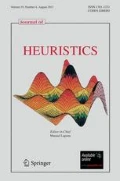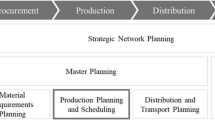Abstract
In this paper, a production planning problem for mixed-model assembly lines in low-volume manufacturing as can be found in aircraft manufacturing is considered. This type of manufacturing is labor-intensive. Low-volume production of huge-sized jobs, i.e. airplanes, is typical. Balancing labor costs and inventory holding costs assuming a given job sequence is the purpose of this paper. Therefore, worker assignments to each station and start times and processing times for each job on each station are determined. Two different mathematical models are proposed. The first formulation is a time-indexed linear formulation that allows for a flexible allocation of workers to periods and stations while the second one has a non-linear objective function and allows only for a fixed assignment of workers to stations. It is proven that the second formulation leads to a linear program with continuous decision variables if the values of the decision variables that determine the number of workers assigned to a station are given, while the first formulation contains even in this situation binary decision variables. Heuristics that hybridize the mathematical formulations with variable neighborhood search techniques are proposed. Computational experiments on randomly generated problem instances and on real-world instances demonstrate the high performance of the heuristics.






Similar content being viewed by others
References
Altemeier, S., Helmdach, M., Koberstein, A., Dangelmaier, W.: Reconfiguration of assembly lines under the influence of high product variety in the automotive industry—a decision support system. Int. J. Prod. Res. 48(21), 6235–6256 (2010)
Battaïa, O., Delorme, X., Dolgui, A., Frédéric, G.: Flow line balancing problem: a survey. In: Proceedings of the 6th International Conference on Industrial Engineering and Systems Management, pp. 1065–1071 (2015a)
Battaïa, O., Delorme, X., Dolgui, A., Hagemann, J., Horlemann, A., Kovalev, S., Malyutin, S.: Workforce minimization for a mixed-model assembly line in the automotive industry. Int. J. Prod. Econ. 170, 489–500 (2015b)
Battaïa, O., Dolgui, A.: Taxonomy of line balancing problems and their solution approaches. Int. J. Prod. Econ. 142, 259–277 (2013)
Biele, A., Mönch, L.: Using simulation to improve planning decisions in mixed-model assembly lines. In: Proceedings of the 2015 Winter Simulation Conference, pp. 2148–2159 (2015)
Borreguero, T., Mas, F., Menéndez, J.L., Barreda, M.A.: Enhanced assembly line balancing and scheduling methodology for the aeronautical industry. Procedia Eng. 132, 990–997 (2015)
Boysen, N., Fliedner, M., Scholl, A.: Production planning of mixed-model assembly lines: overview and extensions. Prod. Plan. Control 20(5), 455–471 (2009a)
Boysen, N., Fliedner, M., Scholl, A.: Sequencing mixed-model assembly lines: survey, classification and model critique. Eur. J. Oper. Res. 192(2), 349–373 (2009b)
Bukchin, J., Dar-El, E.M., Rubinovitz, J.: Mixed model assembly line design in a make-to-order environment. Comput. Ind. Eng. 41(4), 405–421 (2002)
Cambell, G.M., Diaby, M.: Development and evaluation of an assignment heuristic for allocating cross-trained workers. Eur. J. Oper. Res. 138, 9–20 (2002)
Camm, J., Magazine, M.J., Polak, G.P., Zaric, G.S.: Scheduling parallel assembly workstations to minimize a shared pool of labor. IIE Trans. 40, 749–758 (2008)
Chao, J.S., Graves, S.C.: Reducing flow time in aircraft manufacturing. Prod. Oper. Manag. 7(1), 38–52 (1998)
Gómez, A., Rios, J., Mas, F., Vizán, A.: A method and software application to assist in the conceptual design of aircraft final assembly lines. J. Manuf. Syst. 40(1), 37–53 (2016)
Hansen, P., Mladenovic, N.: Variable neighborhood search: principles and applications. Eur. J. Oper. Res. 130, 449–467 (2001)
Hansen, P., Mladenovic, N., Moreno Pérez, J.A.: Variable neighbourhood search: methods and applications. Ann. Oper. Res. 175(1), 367–407 (2010)
Heike, G., Ramulu, M., Sorenson, E., Shanahan, P., Moinzadeh, K.: Mixed model assembly alternatives for low-volume manufacturing: the case of the aerospace industry. Int. J. Prod. Econ. 72, 103–120 (2001)
Hemig, C., Rieck, J., Zimmermann, J.: Integrated production and staff planning for heterogeneous, parallel assembly lines: an application in the automotive industry. Int. J. Prod. Res. 52(13), 3966–3985 (2014)
Hytönen, J., Niemi, E., Toivonen, V.: Optimal workforce allocation for assembly lines for highly customised low-volume products. Int. J. Serv. Oper. Inf. 3(1), 28–39 (2008)
Kolisch, R.: Make-to-Order Assembly Management. Springer, Berlin, Heidelberg, New York (2002)
Lee, C.Y., Vairaktarakis, G.L.: Workforce planning in mixed model assembly systems. Oper. Res. 45(4), 553–567 (1997)
Liu, Z., Kim, D., Chua, H., Yeoh, K.-W.: Aggregate production planning for shipbuilding with variation-inventory trade-offs. Int. J. Prod. Res. 49(20), 6249–6272 (2011)
Lu, H., Liu, X., Pang, W., Ye, W., Wei, B.: Modeling and simulation of aircraft assembly line based on quest. Adv. Mater. Res. 569, 666–669 (2012)
Majohr, M.F., Rose, O.: A Simulation-based workforce scheduling heuristic for complex assembly lines. In: Proceedings of the 2008 Operational Research Society Simulation Workshop (2008)
Maniezzo, V., Stützle, T., Voß, S. (eds.): Matheuristics: Hybridizing Metaheuristics and Mathematical Programming. Annals of Information Systems. Springer, New York (2010)
Martello, S., Toth, P.: Knapsack Problems: Algorithms and Computer Implementations. Wiley, Chichester, New York (1990)
Menéndez, J.L., Mas, F., Serván, J., Ríos, J.: Virtual verification of an aircraft final assembly line industrialization: an industrial case. Key Eng. Mater. 502, 139–144 (2012)
Noack, D., Rose, O.: A simulation based optimization algorithm for slack reduction and workforce scheduling. In: Proceedings of the 2008 Winter Simulation Conference, 1989–1994 (2008)
Polat, O., Kalayci, C.B., Mutlu, Ö., Gupta, S.M.: A two-phase variable neighbourhood search algorithm for assembly line worker assignment and balancing problem type-II: an industrial case study. Int. J. Prod. Res. 54(3), 722–741 (2016)
Rios, J., Mas, F., Menendez, J.L.: A review of the A400M final assembly line balancing methodology. AIP Conf. Proc. 1431, 601–608 (2011)
Rios, J., Mas, F., Menéndez, J.L.: Aircraft final assembly line balancing and workload smoothing: a methodological analysis. Key Eng. Mater. 502, 19–24 (2012)
Rose, C.D., Coenen, J.M.G.: Automatic generation of a section building planning for constructing complex ships in European shipyards. Int. J. Prod. Res. 54(22), 6848–6859 (2016)
Talbi, E.-G.: Combining metaheuristics with mathematical programming, constraint programming and machine learning. Ann. Oper. Res. 240, 171–215 (2016)
Vairaktarakis, G.L., Cai, X., Lee, C.Y.: Workforce planning in synchronous production systems. Eur. J. Oper. Res. 136(3), 551–572 (2002)
Voß, S., Woodruff, D.L.: Introduction to Computational Optimization Models for Production Planning in a Supply Chain, 2nd edn. Springer, New York (2006)
Zäpfel, G., Wasner, M., Braune, R.: Integration between flow scheduling and personnel allocation in a parallel line system in automotive industry. Zeitschrift für Betriebswirtschaft 82(4), 417–432 (2012)
Ziarnetzky, T., Mönch, L., Biele, A.: Simulation of low-volume mixed model assembly lines: modeling aspects and case study. In: Proceedings of the 2014 Winter Simulation Conference, pp. 2101–2112 (2014)
Acknowledgements
The authors would like to thank Dr. Ingo Krohne from AIRBUS for various insights into the discussed problem and for the support of the data collection effort. This research was partially funded by the European Commission Seventh Frame-work Program FP7/2007-2013 under the project ARUM, grant agreement no 314056. The authors gratefully acknowledge the provided financial support.
Author information
Authors and Affiliations
Corresponding author
Rights and permissions
About this article
Cite this article
Biele, A., Mönch, L. Hybrid approaches to optimize mixed-model assembly lines in low-volume manufacturing. J Heuristics 24, 49–81 (2018). https://doi.org/10.1007/s10732-017-9357-6
Received:
Revised:
Accepted:
Published:
Issue Date:
DOI: https://doi.org/10.1007/s10732-017-9357-6



